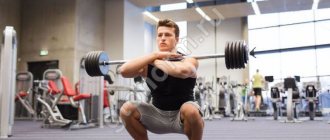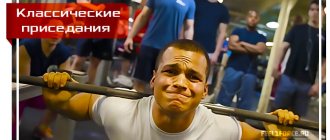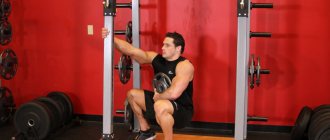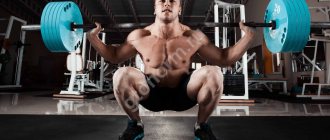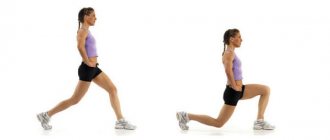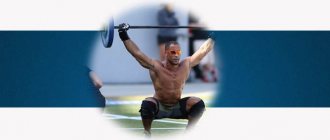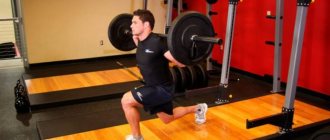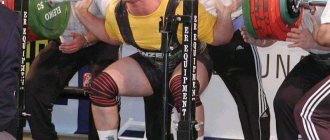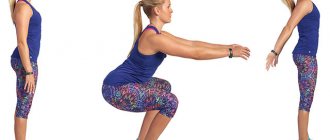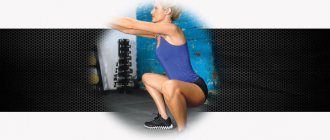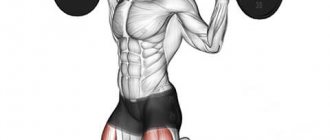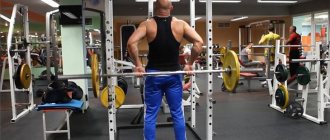- August 4, 2018
- Workouts in the gym
- Anastasia
According to most athletes, squats and deadlifts are two parts of one integral process, therefore, which of them is better is an eternal question, since it is quite difficult to separate them in principle. However, many beginners are concerned about this issue, because they want to quickly achieve the desired results, but experience some difficulties in approaching the sports program. In this article, we will analyze each exercise separately and find out all the benefits of the exercises, and in conclusion we will conclude which is better: squats or deadlifts.
Relationship between exercises
It is known that there is a certain connection between the squat and the deadlift. These two exercises are basic in strength sports; they develop the muscles of the back and legs, while perfectly complementing each other in training. In addition, these exercises demonstrate a similar execution technique. In both cases, the athlete needs to hold the thoracic and dorsal sections straight.
In squats, the legs receive about 60% of the load and the back 40%. The deadlift puts 60% tension on the back muscles and 40% tension on the legs. When the legs are trained in squats, the effectiveness of the deadlift increases, the same thing happens in reverse. The opposite effect can be found this way: if you don’t squat, the deadlift will be bad. On the other hand, without deadlifting, it will be more difficult to pump up your buttocks and legs. Both exercises give a good load on the following muscle groups: external and internal muscles of the thighs, abdomen, back and lower legs.
From here it becomes clear how, when performing a deadlift or squat, almost the entire body of an athlete is tensed and why it is so difficult to single out an exercise that will bring more benefits.
Barbell squat technique
Before training, be sure to warm up. Below is an example of a warm-up complex that is suitable for almost everyone, even a beginner athlete.
- Cardio. 10-15 minutes of exercise on a treadmill or elliptical trainer will be enough. This way you will warm up your muscles and prepare your cardiovascular system for power loads.
- Leg extensions in the simulator. Do not install too much weight! Your goal is to prepare your knee joints for work and warm up your quadriceps. Three sets of 15–20 extensions will be enough.
- Hyperextension. During this exercise, the muscles of the hips, buttocks and back are used. The lower back is prepared for the stress of a squat. Small muscles connected to the spine also begin to work. It is almost impossible to use them with other exercises.
Warm-up1
Cardio on the treadmill
Cardio on the treadmillWarm-up2
Hyperextension
HyperextensionWarm-up 3
Leg extension
Leg extensionAfter warming up, start the exercise. If you are a beginner, then a bar weighing 10 kg is enough. It will make it easier to control the load. To begin, perform squats with an empty barbell.
Execution technique (deep squat with weight)
- The grip should be slightly narrower than shoulder width, but if you have long limbs, you can take it wider. Position the barbell so that its center is between the trapezius muscles just below the neck. For convenience, first bring your shoulder blades together. Move your pelvis back slightly. There should be a slight natural arch in the lower back.
- The key point is the placement of the legs. Your feet should be approximately shoulder-width apart and turned slightly outward. Each person's position may be slightly different, but the bottom line is that you should be firmly on the floor and able to squat deeply without losing your balance.
- Next, while inhaling, sit down, spreading your hips and knees to the sides. At the same time, the back remains straight and moves slightly forward, the abs are kept tense. The gaze is directed forward, but not upward. Lower yourself until your thighs are parallel to the floor.
- Next, as you exhale, begin to rise. The emphasis, for the most part, should be on the heels, pushing the floor with them. Stretch up with your chest, not your forehead. The gaze remains directed forward, and the knees remain turned outward. Exhale at the top end point.
Squat
Classic barbell squat
Classic barbell squat The number of approaches and repetitions depends on your level of physical fitness and your goals. If you want to lose weight, then use high-repetition training. For example, 3-5 sets of 15-20 reps with light weight. If your goal is to gain muscle mass, then stop at a low number of repetitions (5-10 times) in 3-5 approaches. The weight should be enough so that you can perform the exercise correctly, but at the same time the last approach is performed with all your strength.
Common exercise mistakes, let's do it right
- Lack of attitude. If today for any reason you feel sluggish and relaxed, it’s better not to approach the barbell. This is a strength exercise, and the lack of general tone can lead not only to a lack of results, but also to injuries, falls and other unpleasant consequences.
- Asymmetrical neck position. One of the most common mistakes among beginners. The center of the bar moves to the side, as a result of which the bar can tilt and cause the athlete to fall.
- Bringing the knees inward. In this position, the knee joints become very vulnerable. When working with heavy weights, there is a risk of seriously damaging them.
- Lifting your heels off the floor. If this problem is relevant to you, then first practice confidently squatting without a load. Often this problem is a consequence of bringing the knees forward, beyond the toes.
- Rising on tiptoes. At the top end of the exercise, your feet should also be firmly on the floor. Forget about ballet tricks!
- Tilt of the body forward. The consequence of this mistake will be loss of balance and insufficient squat depth.
- Incorrect height. Excessive lowering of the pelvis (below parallel with the floor) increases the load on the hips. If your goal is to build muscle mass in your legs, then this is allowed. But if you dream of a round butt, then your hips at the lowest point should be parallel to the floor. Insufficient depth of squats does not allow the muscles to fully engage in work. The knees, on the contrary, are subject to excessive stress, which can lead to damage to the knee joint.
Deadlift
Which is better - squats or deadlifts? To understand this issue, you should consider each exercise separately and identify the main advantages.
Benefits of deadlift:
- Metabolism improves.
- There is an increase in muscle mass.
- Tendons and joints are strengthened.
- Stimulates the growth of the body as a whole.
- There is a load on almost all muscle groups.
This exercise distributes the load throughout the body. The leg and gluteal muscles, abs and lower back, and torso are worked out. The classic deadlift is quite simple:
1. With a slight bend in your knees, you need to lean forward and grab the bar.
2. The back bends slightly in the lower back, while the chest and shoulders are straightened. The bar rises to the shin.
3. From this position, you need to slowly lift the bar up without bending your back or leaning back.
4. Then, moving your pelvis back and bending your knees, lower the machine.
5. At the last point, the thighs tighten and the bar rises up again.
The exercise is the most standard among other types of deadlifts, but it works the latissimus dorsi, hamstrings and triceps.
Deadlifts can also be performed using dumbbells; this option is the safest compared to the previous one, and the working effect is no less noticeable.
Read also[edit | edit code]
- Exercises of the past
- The best exercises for gaining muscle mass
- Legs - exercises and training features
- Plie squat
- Pumping the gluteal muscles
- Zhanna Rotar: exercises for legs
- How to pump up leg muscles
- Squats with a barbell for girls
- Squats with a barbell on your shoulders
- Barbell Squat
- Front Squats
- Wide-legged barbell squats
- Forward bends with a barbell
- Bent-overs with a barbell on your shoulders
Squats
The benefits of squats are quite impressive in any sport. This exercise helps:
- Increased muscle mass.
- Burning fat.
- Mobility.
- Improved coordination.
- Increased efficiency.
- Preventing injuries.
- Development of the central part of the body.
- Strengthening joints.
- Increased flexibility.
- Increasing endurance.
From the above list of benefits, it is clear that this universal exercise brings great benefits, which is why it is considered the basis of all training.
Correct execution of squats:
1. Body position is straight, legs are slightly wider than shoulder-width apart.
2. With a deep breath, bending your knees, you should slowly lower yourself to 90 degrees to the level of your hips.
3. Exhale and return to the starting position. Perform 20 times in one approach. The number of approaches increases depending on the condition of the body.
Foot width and bar position
Here, in principle, everything is simple - the closer the legs are to each other, the more load the quadriceps receive. However, when lowering down, the lower back will round faster than with a wider stance. A wide stance will allow you to work the adductor muscles of the hips.
The position of the bar on the back can also be different, unlike the front squat, where there can only be one position - on the front delts. There are two positions of the bar on the back - high and low. Typically the high position is used by bodybuilders and weightlifters. In this version, the barbell is located on the upper parts of the trapezius muscles. The low bar position is usually used by powerlifters. The barbell is placed lower, at the level of the rear delts. As a rule, in this version they use a wide stance of the legs; in this design, the torso bends more. All these manipulations allow you to take more weight than when the bar lies high.
Comparison
It is not customary to choose between squats and deadlifts. But there are times when you still need to choose.
The deadlift will be an alternative option in case of an injury that limits the range of movement. With the right approach to training, this exercise can achieve good results without full squats. During barbell lifts, the quadriceps area is less loaded. Therefore, if discomfort is felt during squats, many athletes practice deadlifting. This is the case when doing deadlifts instead of squats.
Squats, in turn, play a huge role in training for any athlete. It improves the hip joint and other lower joints.
How to squat correctly with an elastic band on your legs?
If you're worried that you don't know how to squat properly with bands on your legs, relax. The accessory does not require any special technique; the most important thing is to know the correct algorithm for performing each exercise without an expander.
However, in order for the question “how to squat with an elastic band for fitness” to be finally resolved, read the following recommendations:
- Never skip the warm-up and cool-down - muscles and ligaments need to be warmed up and prepared for work;
- Breathe correctly - in squats, inhale always on the way down, exhale on the way up;
- Never exercise if you don't feel well;
- We recommend choosing an accessory with a non-slip surface to make it more convenient to exercise.
- Wear long, tight-fitting pants while exercising to avoid chafing and injury to the skin of your legs.
- Of course, use an expander with a level of rigidity that suits you;
- Never stop there - regularly increase the load.
Well, that's all, we told you about all the features of using a band for squats. Now your legs will become even slimmer and your body toned. Have fun with your training!
What's better
Each exercise has its benefits, but how do you decide which is better - squats or deadlifts? The difference between two similar and important exercises is as follows.
Beginners should only perform deadlift exercises with light weights. When the muscles become stronger, you can increase the weight, usually after six months of active training. Squats do not require special preparation.
At the first stages, experiments are not recommended. It is necessary to perform the traditional technique. Squats can be performed in different conditions and variations.
Deadlifts are dangerous for the untrained, especially for thin people with weak muscles. Squats do not require experience and are suitable for everyone; they provide a strengthening effect in different forms.
There is a slight difference between squats and deadlifts. To understand which of them is most suitable, you should understand the ultimate goal of training and ensure the correct distribution of the load. By mastering many techniques, the squat can provide excellent development of the lower back, while the deadlift will strengthen the body almost completely. We must not forget that the exercises are related to each other and the best results will be achieved when they are combined.
Advantages and disadvantages
What are the benefits of squats for the buttocks with bands on the legs, let's find out!
- It allows you to comprehensively distribute the load, turning it from point to uniform.
- This is an excellent alternative to weights, which are often prohibited for medical reasons. Even athletes with a sore spine can use an elastic band;
- Expanders place virtually no load on the joints;
- Squats with a rubber band are difficult to perform incorrectly - your body, in order to make the task easier for itself, intuitively performs the exercise technically correctly;
- Due to different levels of rigidity, you can easily change the load, which is very convenient;
- The accessory can be used at home, in the gym, and on the street. It folds compactly and fits in any, even very small bag.
- It allows you to burn 200-300 additional kcal to the usual amount when doing squats without a band.
- Such training will make the skin more elastic and eliminate sagging and cellulite.
Of course, there are also disadvantages. First of all, this is the load limit. You can increase the weight on the bar as much as you like, but you won’t put 15 elastic bands on yourself, no matter how much you want to. Secondly, expanders will not help to significantly build muscle, only to form a relief. In order to grow muscles, strength training with weights is necessary. Accordingly, this accessory is not suitable for men seeking to improve their figure, but is ideal for women training to lose weight.
Equipment
Proper equipment for an athlete is very important, even if you are training at home. Any type of squat using a barbell puts a lot of stress on the knees. This is especially true for those bodybuilders who practice heavy weights. Therefore, if your knees hurt after training or if you want to take care of their protection in advance, purchase knee pads. The effect of knee pads is twofold:
- Maintains heat in the joint.
- They fix the joints, preventing the ligaments from overstretching.
They have knee pads and another classification:
- Restorative. Designed to be worn if your knees hurt and the pain syndrome occurs after a traumatic injury. Rehabilitation knee pads have a fairly rigid frame that prevents bending of the knee joint. They securely fix the knees and protect them from “loosening”. They are removed before training.
- Knee pads for fitness. They practically do not interfere with movements. They are used during training, that is, they can be used to do squats, including multi-repetition ones.
It should be noted that if your knees hurt regularly after training, then something in the training process is going wrong. You may be lifting too much weight or using the wrong technique. In any case, if your knees hurt before or during training, it is better not to put a lot of stress on the joint.
Errors in squatting with equipment
- Double movement . Up we work until the end. We are not afraid to go down and sit down quickly and confidently, in one movement, to the desired level or the coach’s command. The first and second approaches are always better to sit down with a reserve than not to finish. 3rd or record you can sit higher, but strictly according to the rules.
- Falling after a squat . Either out of joy that they got up, they relaxed ahead of time, or they didn’t straighten their back when getting up. When you get up, you need to gradually straighten your lower back as you straighten your knees. So that the slope at the top is no more than 15-20 degrees. Do not forget: the movement is completed only after the command “To the racks”.
- Nedosed . Either you were afraid to finish your workout, which is unacceptable for a powerlifter, or you didn’t warm up properly and your overalls weren’t tight enough. Always sit parallel or even lower on the last warm-up set.
- Falling while moving down . They didn’t arch their back enough and stuck their buttocks out back. The consequence is that your knees came out forward and you fell. The first rule of squatting is that your KNEES SHOULD NOT GO BEYOND YOUR TOES!
- Dropping the barbell . Bent your back too much when moving down. Remember, you squat with your legs, not your back. Do not tilt your back below 45 degrees, this is dangerous. In general, you can be disqualified from the competition for throwing off the barbell twice. When squatting in a monolift, weight loss due to loss of balance at the start indicates that the starting stance was incorrectly selected (the legs were either moved far forward beyond the bar (the bar fell back) or remained behind the bar (the bar fell forward over the head).
The faster and more confidently you sit down, the easier it will be to get up! Just remember to keep your back.
Common mistakes
Rounded back. Your back must be kept straight at all times. Sometimes some powerlifters intentionally round their upper back in order to reduce the trajectory of the barbell. This specific movement in the sport, although incorrect, is suitable for some experienced athletes. Definitely not suitable for beginners.
Hyperextend at the top when lifting. Has become very popular in deadlift competitions where you need to quickly show that you have achieved full extension. But the back should still remain in a neutral position, even at the top.
The buttocks rise faster than the chest. The chest should guide the movement, and the whole body should follow upward at the same pace.
Use the squat technique . The exercise does not begin in a sitting position. This is a completely different movement.
Exercising too frequently/infrequently. Many training programs involve performing deadlifts once a week (with a barbell or dumbbells).
Sudden movements and jerks. Although everywhere it is recommended to do deadlifts in the form of an explosive movement - this should be a coordinated movement of all muscles involved in the exercise, and not jerks with the head, arms or back.
Start the exercise without warming up (1-2 sets with light weight).
The barbell is too far from the body. In fact, you literally have to drag it up along your shins and thighs. That's why many professional powerlifters wear high socks to avoid damaging their skin.
Barbell toss. This means lowering the projectile too quickly and using the bounce from the floor to push it back up again. This is very tempting because it allows you to do more repetitions, but it is fundamentally wrong. At the same time, strength and muscle mass do not increase. This becomes obvious if you are trying to lift as much weight as possible in one set (one rep max). Don't be surprised if you have difficulty lifting a weight 1 time that you can lift with hops 5 times, because you are not the one lifting those 5 reps. The heaviest phase of this heavy compound exercise comes from jumping. Naturally, all this also increases the risk of injury. The bar can bounce and injure your shins, or move too far away from you and injure your lower spine.
Do not touch the barbell to the floor. Keeping the weight in the air throughout the entire set is bad for your back. And when she gets tired, she involuntarily rounds, which is dangerous. Allow your spine to completely relax between repetitions, as you lower the barbell completely to the floor. Then take a deep breath and repeat again. This will make you stronger and your spine will be safe.
Throwing a barbell. Very often, athletes, especially in CrossFit, like to throw a projectile from the top of the exercise.
In this case, you can break the pancakes, barbell or floor.
Lowering the barbell also works the muscles well, but throwing the barbell means you miss out on the opportunity to increase strength and muscle mass.
Use of mirrors. Looking in a mirror is not the most effective way to test proper technique. It is not visible in the mirror whether the back is in a neutral position. You only see the position of the feet and legs. If you stand sideways to the mirror, you can see the position of your back only by turning your head. In this case, there is a high probability of pulling the neck muscles. The best way is to videotape your approaches from different angles. Review the recording between approaches and make adjustments. This way you will definitely improve your technique.
A little history
More than one world record has been recorded among men for performing squats, including with a barbell. Most amazing achievements:
- G. Heisey in triathlon set a world record in deadlift and chest press with a weight of 1148 kg.
- Paul Anderson lifted the 2,844 kg weight, which consisted of two safes with metal dollars inside, off the racks with his shoulders.
- Andrei Malanivich's world record was 450 kg in squats with bandages.
Unusual world records have been set in barbell squats. Brazilian Edmar Freitas squatted 111 thousand times per day, taking breaks of only 5 minutes.
Currently, standards have been developed for professionals. Moreover, there are standards not only for men, but also for young men. Approximate standards:
- For a candidate for master of sports, an athlete must gain 665 kg in 3 exercises.
The standards for powerlifting in the NAP are slightly different. For example, standards for the stronger sex:
- An athlete weighing 100 kg must gain a total of 953 kg.
NAP standards for women:
- In powerlifting, with a weight of 60 kg, a woman must gain 457 kg.
Some organizations allow doping but prohibit the use of equipment, so regulations may vary. More detailed information can be found on specialized websites.
High repetition squats[edit | edit code]
High rep squats
is a barbell squat method that features a high number of repetitions (an average of 20 per set). According to many authors, they cause a number of positive physiological reactions that are beneficial when practicing bodybuilding (growth, muscle definition) and powerlifting (strength, endurance). Often used to break a training plateau by experienced athletes, although it can be used in training programs for beginners. Gained popularity after the publication of Dr. Strossen's book in 1989, “Super Squats: How to Gain 30 Pounds of Muscle in 6 Weeks,” and was also actively used by Brooks Kubik. Faleev denies the usefulness of this method.
The main advantage is that the leg muscles (quadriceps) contain mainly slow-twitch muscle fibers, which require more repetitions to train and hypertrophy. The National Federation of Personal Trainers recommends 20-25 repetitions for muscles that contain predominantly this type of fiber.
Moreover, there is an unconfirmed belief that deep, high-repetition squats allow you to expand the chest, and cause increased secretion of growth hormone, while you need to follow a special deep breathing technique, which is described in the main article.
High-rep squats are often recommended during cutting and burning fat, as they allow you to burn the maximum amount of fat due to the greater volume of muscle cell work. At the same time, the number of mitochondria, the main consumers of fatty acid energy, increases significantly.
Scientific background edit | edit code
In 2004, a scientific paper was published in the Journal of Strength and Conditioning Research, in which scientists concluded that a combination of high-repetition and low-rep exercises is more effective for muscle growth and strength, compared to using only one of these approaches.
Example training programedit | edit code
https://youtube.com/watch?v=HuD9kRWyZ2k%3F
Video example (according to Strossen) 1x20
Multi-Rep Squat Technique (Strossen): Take the weight you squat with 10 times (aim to reach 150% of your body weight) and squat with it 20 times. Due to the increase in weight, the duration of the exercise increases to 5 minutes due to long rests between repetitions. This completes the leg training; in the next workout, a 2.5 kg heavier weight is used. A long rest period between leg workouts is required for full recovery (3-7 days).
Strossen, in his book “Super Squats,” argues that the enormous stress that such a load puts on the body provides a powerful stimulus for growth in both mass and strength. During the execution, you need to breathe deeply and intensely.
After 10-15 repetitions, it no longer matters how many inhalations and exhalations you have to take to complete another repetition, the main thing is that it still takes place, and with the correct technique. With each repetition, the rest time increases
After training in squats in a similar manner for two to three months, you will be able to gain some experience, which will best tell you about the effectiveness of the proposed training method.
Here is an example of leg training (one day using a split program).
- Squats with a barbell 4x7,10,20,25
- Leg curls in the machine 3x15
- Standing calf raise 3x20
Or:
Squats with a barbell 10x10 - rest between sets approximately 1 minute
Or:
- Squats with a barbell 1x20
- Leg press 3x6
- Leg curls in the machine 3x15
- Standing calf raise 3x20
Basic program for beginners:
- Barbell squats: 1×20
- Pullovers: 1×20
- Deadlift: 1×15
- Pullovers: 1×20
- Bench Press: 2-3 x 10
- Bent-over barbell row (video): 2-3×15
- Military press: 2-3 x 12
In addition to doing 20 reps of squats, trainees are advised to follow an appropriate diet and get enough rest. Remember to progressively increase the weights with each new leg workout.
